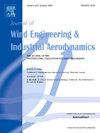Impact of sloped terrain on wind loads in high-rise Buildings: An experimental wind tunnel investigation
IF 4.9
2区 工程技术
Q1 ENGINEERING, CIVIL
Journal of Wind Engineering and Industrial Aerodynamics
Pub Date : 2025-07-01
DOI:10.1016/j.jweia.2025.106156
引用次数: 0
Abstract
Topographic wind effects can significantly enhance wind loads on high-rise buildings, leading to structural damage, occupant discomfort, and increased safety risks. This study investigates the impact of sloped terrain on wind loads through synchronized pressure measurements in a wind tunnel. We tested square-sectioned high-rise building models under various slope gradients and building-slope spacings. Our analysis systematically compared disturbed wind profiles, surface pressure distributions, and wind forces on the building model across different terrains. The findings indicate that sloped terrains intensify flow acceleration, amplifying mean wind pressures by approximately 20 % on upper building sections (z/H > 0.7) compared to flat terrain. Moreover, terrain-induced turbulence increases fluctuating pressures and alters flow structures near a building's base. Interestingly, the increase in terrain slope is positively associated with the intensity of terrain-induced turbulence; however, flow acceleration does not exhibit a linear relationship with the terrain slope. Under identical terrain heights, a mild slope may induce a great degree of acceleration, leading to a more substantial increase in wind loading. These results provide direct evidence for wind load regulations for buildings situated in sloped terrain.
斜坡地形对高层建筑风荷载的影响:风洞试验研究
地形风效应会显著增强高层建筑的风荷载,导致结构破坏、乘员不适,增加安全风险。通过风洞同步压力测量,研究了斜坡地形对风荷载的影响。我们测试了不同坡度和建筑-斜坡间距下的方形高层建筑模型。我们的分析系统地比较了不同地形的扰动风廓线、地表压力分布和建筑模型上的风力。结果表明,倾斜地形加剧了气流加速,使建筑上部截面的平均风压增加了约20% (z/H >;0.7)与平坦地形相比。此外,地形引起的湍流增加了波动压力并改变了建筑物底部附近的流动结构。有趣的是,地形坡度的增加与地形引起的湍流强度呈正相关;但水流加速度与地形坡度不呈线性关系。在地形高度相同的情况下,平缓的坡度可能引起较大程度的加速度,从而导致风荷载更大幅度的增加。这些结果为坡地建筑的风荷载规律提供了直接依据。
本文章由计算机程序翻译,如有差异,请以英文原文为准。
求助全文
约1分钟内获得全文
求助全文
来源期刊
CiteScore
8.90
自引率
22.90%
发文量
306
审稿时长
4.4 months
期刊介绍:
The objective of the journal is to provide a means for the publication and interchange of information, on an international basis, on all those aspects of wind engineering that are included in the activities of the International Association for Wind Engineering http://www.iawe.org/. These are: social and economic impact of wind effects; wind characteristics and structure, local wind environments, wind loads and structural response, diffusion, pollutant dispersion and matter transport, wind effects on building heat loss and ventilation, wind effects on transport systems, aerodynamic aspects of wind energy generation, and codification of wind effects.
Papers on these subjects describing full-scale measurements, wind-tunnel simulation studies, computational or theoretical methods are published, as well as papers dealing with the development of techniques and apparatus for wind engineering experiments.

 求助内容:
求助内容: 应助结果提醒方式:
应助结果提醒方式:


